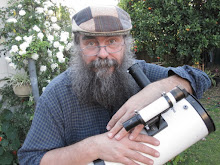Saturday, January 25, 2025
Another comet C/2024 G3 Atlas update (updated 28 January 2025)
| Chart showing location of the comet on the 29th of January, it is visible in binoculars from 60 minutes after sunset and (just) with the unaided eye by 90 minutes, you may need averted vision to see it. In binoculars, sweep over from Venus and Saturn just past bright Fomalhaut. The comet will be just above a distinct “W” (or "U")shaped asterism for the next few nights, near the trail of stars from Grus. Click to embiggen. | Black and white printable spotters map to help with finding the comet. Venus and Saturn are good signposts to the location of the comet. I have not indicated magnitudes as I have no reliable magnitude predictions. The comet is fading but as of yesterday was just visible to the unaided eye with averted vision and easily visible in binoculars. The comet is also heading into darker skies and so is likely to be visible for a while. Click to embiggen and print. |
| Zoomed in binocular view showing location of the comet on the 29th of January. In binoculars, sweep over from Venus and Saturn just past bright Fomalhaut. The comet will be just above the distinct “W” (or "U") shaped asterism you can see near the bottom of the image for the next few nights, near the trail of stars from Grus. the asterism is very clear in binoculars. Click to embiggen. | Black and white printable binocular map to help with finding the comet. Venus and Saturn are good signposts to the location of the comet. As is the tail of stars from the bright pair that are the main stars of Grus. If you run into them, you have swept too far south, move west by a binocular field and search around. As the days go n yu will locate the comet by sweeping up from this asterism. The circle is the approximate field of view of 10x50 binoculars. Click to embiggen and print. |
Despite the nucleus of Comet C/2024 G3 having disintegrated, it is still putting a nice display and should be visible from a few more days to the unaided eye, depending on how much light pollution you have, and much longer in binoculars as it heads higher into darker skies away from the horizon murk. Although fading, it is still visible (just) to the unaided eye from around 90 minutes after sunset, and readily visible in binoculars. There is still around 6 degrees of tail visible, and the comet is pale but marvelous in binoculars. You will need a clear, level horizon for good views (and an absence of clouds).
For photography, you need to mount your camera or phone on a tripod or other stable surface. You will need high ISO settings, (1600, 3200, or 6400) and long exposures (I use between 2 seconds-30 seconds as the comet gets lower in the twilight murk). I also have 2 seconds shutter delay to stop camera/phone vibration ruining the shot.
So, if you have a chance, head out and look low to the south west, using Venus as your guide.
| Comet C/2025 G3 at 10:30 pm AEDST Wednesday 22 January, 30 second exposure at ISO 3200 with my Samsung S24 (23 mm F1.7). Venus and Saturn are to the far right. (click to embiggen) | Comet imaged on Tuesday 28 January at 22:10 ADST 15 seconds exposure showing the comet head in the "W" asterism, and a few faint satellites.Samsung Galaxy S24 Ultra
ƒ/3.4 15s 18.6 mm ISO3200 (click to embiggen) |
Labels: binocular, C/2024 G3, comet, unaided eye
Comments:
<< Home
10.30pm 7 Feb could see Jupiter and Mars quite clearly here in light-polluted Westmead Sydney. Thanks, Liz Fry 🌛
Post a Comment
<< Home










 Click to read about or order
Click to read about or order Click to read about or order
Click to read about or order Click to read about or order
Click to read about or order Click to read about or order
Click to read about or order




